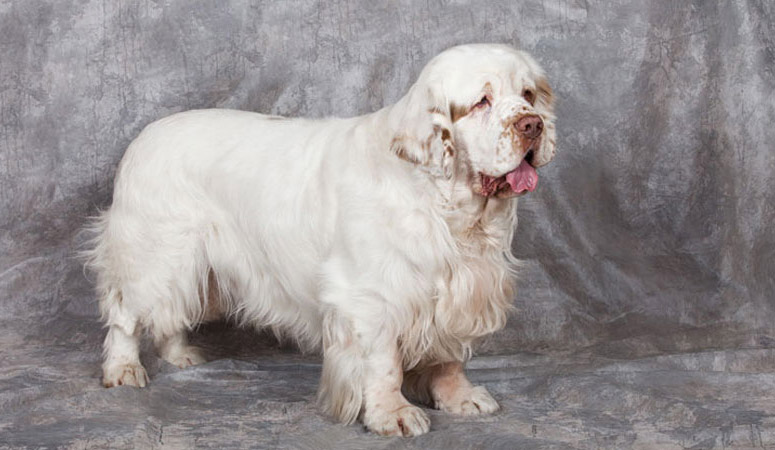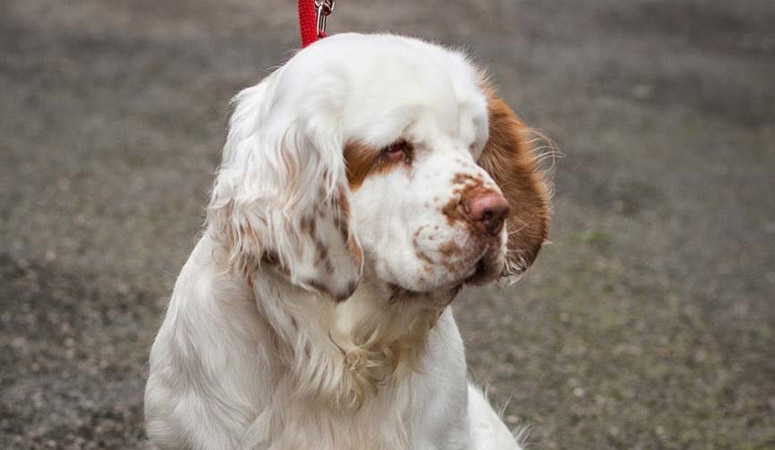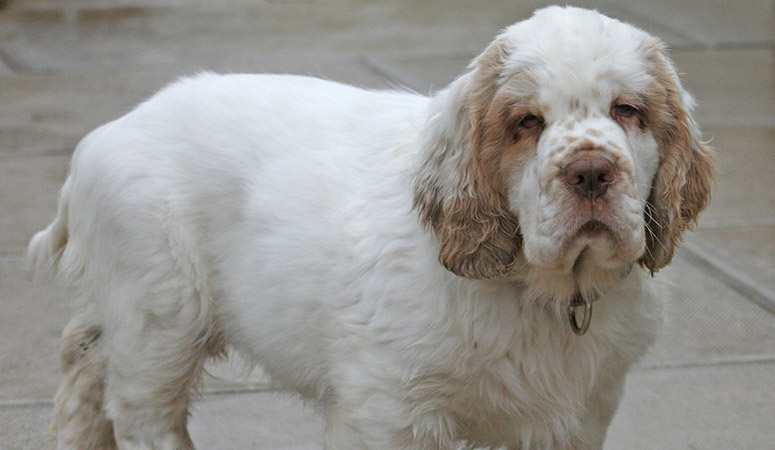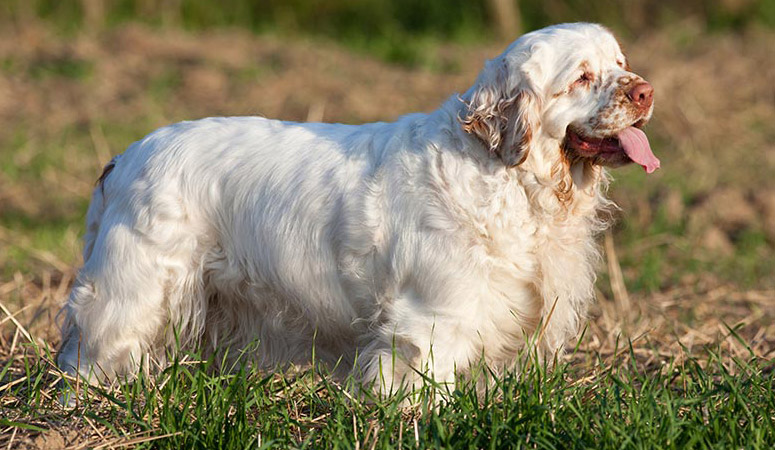Clumber Spaniel
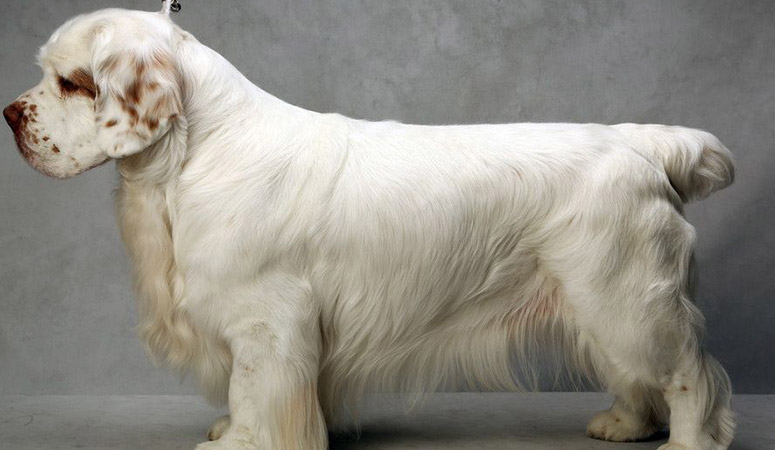
With massive bone and rectangular shape, The Clumber Spaniel is a long, low dog. But his sturdy chest and sturdy chest can help him push through the thickest undergrowth to flush birds during hunting. Although with sweet nature, this breed have a dignified manner. Both laid back and eager to please, Clumber Spaniels are excellent choice for first-time dog owners.
| Other Names | Clumbers |
| Color | White with Lemon Markings or range Markings |
| Height | Males: 18-20 inches. Females: 17-19 inches. |
| Weight | Males: 68-85 pounds. Females: 55-70 pounds. |
| Life Span | 10-12 years |
| Personality | Mellow, Amusing, Gentlemanly |
| Exercise | Regular Exercise |
| Origin |
| Popularity | #134 |
| Groom Needs | Weekly Brushing |
| Kids Friendly | Yes with supervision |
| Dog Friendly | Yes with supervision |
| Watch Dog | |
| Family Dog | |
| Litter Size | 2-8 puppies |
Clumber Spaniel Pictures
Clumber Spaniel Video
Introduction
To describe the Clumber Spaniel aptly, they have, for heads, a gigantic block, decorated with a square nose and muzzle. When combined with the ear-shaped like a vine-leaf, these dogs give the appearance of a mournful predator. However, they are in fact gentle, affectionate, and loyal dogs. The Clumber Spaniel loves the company of its owner, and yet maintains a glaring aloofness to strangers. They come in a weather-resistant coat which is straight and dense. Clumber Spaniels are usually of white color with lemon or orange markings.
The Clumber Spaniel is the largest of all spaniels, a standard male stands 18-20 inches at the shoulder and is likely to weigh in the range of 70-85 pounds. The females are equally large, although they appear slightly smaller than the males. A standard female measures 16-19 inches standing at the shoulder and would weigh around 55-70 pounds at the weighing scales. Clumber Spaniels are members of the Sporting Group. They have an average life expectancy of 10-13 years.
Living with Clumber Spaniel
Clumber Spaniels are considered to be average to heavy shedders, and there will be days when it seems as if it’s snowing Clumber hair in your home.
Daily brushing is a must to keep loose hair to a minimum. Other than that, all you really need to do is trim the hair on their rear legs and tail and between the pads of the feet to keep them looking neat.
Bathing once a month is usually sufficient for a dog who isn’t working regularly in the field. As long as you’re using a shampoo made for dogs, regular baths won’t affect his coat except to make it look clean instead of dingy. Just be sure to rinse thoroughly to prevent itchiness from shampoo residue.
Clumbers don’t require a lot of trimming; their coat is very easy care, requiring little more than a thorough grooming with a brush and a medium comb once or twice a week.
The heavy folds on the head require regular once-overs with a damp cloth. Wrinkles that are not kept dry can easily set up a yeast infection that has a bad odor and is unpleasant for the dog.
Trim nails regularly if your dog doesn’t wear them down naturally. If you can hear them clicking on the floor, they’re too long. Short, neatly trimmed nails keep your legs from getting scratched when your Clumber enthusiastically jumps up to greet you. Handle his paws frequently — dogs are touchy about their feet — and look inside his mouth and ears.
As with all breeds with heavy, lowset ears, routine cleaning of the ears is a must to prevent ear infections.
Brush your Clumber’s teeth at least two or three times a week to remove tartar buildup and the bacteria that lurk inside it. Daily brushing is even better if you want to prevent gum disease and bad breath.
Begin accustoming your Clumber to being brushed and examined when he’s a puppy. Make grooming a positive experience filled with praise and rewards, and you’ll lay the groundwork for easy veterinary exams and other handling when he’s an adult.
A healthy, adult Clumber Spaniel requires about one hour of moderate-intensity physical activity each day.
Despite their lumbering appearance, the Clumber can be a very active dog. They will benefit from long walks, taking occasional breaks to sniff around. Clumber Spaniels adore their families and should live indoors with them.
Clumber Spaniels should spend an hour or two outdoors, playing and exercising. This breed has sedentary tendencies, but they’ll get up and go with encouragement from their owners. Don’t leave your Clumber outdoors alone for very long or he’ll search for a route out of the yard and set off after birds—albeit at an amble.
Daily walk or playtime for 20 or 30 minutes will meet his exercise need. Generally, Clumbers are quiet and are not known as a breed that barks a lot. A fenced yard keeps them safe from loss or theft. Also Clumbers enjoy playing fetch.
Your Clumber pup will chase a ball for as long as you’ll let him, even if he’s tired, so it’s up to you to limit his activity. Give him a break after the fifth fetch or so.
When they’re puppies, however, it’s important to restrict any running on hard surfaces or jumping on and off furniture or sliding around on slick floors and crashing into the wall, which can injure their still-developing joints.
The Clumber should be fed with a high-quality diet. The recommended amount is 2 to 2.5 cups a day, divided into two meals. Puppies may eat as much as 4 to 6 cups a day.
A high-quality dog food appropriate to his age, size, activity level and metabolism. And the quality of dog food you buy also makes a difference — the better the dog food, the further it will go toward nourishing your dog. Talk to your veterinarian about the optimal diet and quantity of food for your Icelandic Sheepdog.
It’s best to feed a mature dog twice a day, once in the morning and then again in the evening, making sure it’s good quality food that meets all their nutritional requirements.
It’s also important that dogs be given the right amount of exercise so they burn off any excess calories or they might gain too much weight which can lead to all sorts of health issues. Obesity can shorten a dog’s life by several years so it’s important to keep an eye on their waistline from the word go.
Clean, fresh water should be available at all times.
Learn about which human foods are safe for dogs, and which are not. Check with your vet if you have any concerns about your dog’s weight or diet.
Clumbers are generally a healthy breed, although certain conditions are sometimes seen, including hypothyroidism (with side effects of skin and ear issues) and entropion or ectropion (eyelids that turn either in or out), intervertebral disc disease, hip dysplasia, otitis externa, seizures and ear infection.
Some health problems don’t appear until a dog reaches full maturity. Not all Clumbers will get any or all of these diseases, but it’s important to be aware of them if you’re considering this breed.
Some Clumbers are prone to colitis, inflammation of the large bowel. If your Clumber has soft stools that contain spots of blood or mucus but otherwise appears healthy, he may have colitis.
Their ears should be checked regularly for signs of infection, and the teeth should be brushed often, using a toothpaste designed for dogs.
There are several health tests considerations specific to the breed, such as hip evaluation, elbow evaluation, PDP1 test and ophthalmologist evaluation.
Responsible breeders test all breeding stock for conditions that can affect the breed. Regular visits to the vet for checkups and parasite control help to ensure the dog a long, healthy life.
Total Annual Cost: $2889
Cost is estimated for the first year and may vary depending on many factors, such as dog food, health care, leash, collar, licensing, possible fencing, crates, training and obedience classes, dog-walking, grooming, treats, toys, flea, tick, and heart-worm meds, microchips, etc.
Clumber Spaniels are excellent bird dogs, with a particular aptitude for following quarry through rough terrain. The Clumber is steady and reliable, thorough and tenacious, which can sometimes make them a challenge to train because they tend to stop and think things through before deciding to do them.
Clumber Spaniels are smart and eager to please. They’ll learn basic obedience commands in a jiffy, especially when training sessions are kept short and fun.
Clumber Spaniels benefit from advanced training and dog sports because these activities prevent them from being couch potatoes and putting on weight.
Puppies should be properly socialized to develop the amiable, outgoing personality that is characteristic of the breed. They’re successful in performance and companion events such as earthdog, barn hunt, obedience, and agility.
Crate training is a wonderful tool to help in house training, and a crate also provides a safe haven for your Clumber Spaniel when you are gone. Clumbers are known for their ability to get into things, even as adults, so this ensures that both your dog and your belongings are safe when you are away.
An abundance of praise and dog treats also help. Keep training sessions interesting to keep their attention on learning instead of searching for something more fun to do. Most will require a reason to do as they are told. They do not take well to a heavy-handed trainer, however.
History
The Clumber Spaniel is about the largest spaniel dog to have been bred in the United Kingdom. This breed has an interesting history, although not much is known about their history prior to the mid-1800s. There are two theories, however, which attempt to explain the history of the Clumber Spaniel. One of them suggested that the breed had begun its existence in France before it was imported into the United Kingdom where it was further bred into a distinct breed as it is known today. According to the same account, the Duc de Noailles presented some of his finest spaniels to the Duke of Newcastle in Clumber Park, Nottinghamshire, claiming that the Pyrenean Mountain Dog was bred with the Basset Hound and the Alpine Spaniel to give rise to the Clumber Spaniel.
Another theory states that the old Bleinheim Spaniels were crossed with King Charles Spaniels, which led to Clumber Spaniel descendants. Whichever way it goes, what’s certain is that these dogs were properly developed in Clumber Park, by William Mansell, a gatekeeper at the Duke’s place. Along the line, the Clumber Spaniel breed had its own share with fame and royalty. Having been a key member of Prince Albert’s kennel in the Victorian era. More so, his son, King Edward VII also had quite a reputation for breeding Clumber Spaniels in his Norfolk residence.
It wasn’t until the 1850s that the common people of England began to breed the Clumber Spaniel. However, breeding ceased during World War I, leading to a drastic decline in the breed’s population. The Clumber Spaniel came into America in the mid-1800s, although it only became popular in the 1960s. The Clumber Spaniel became one of the first dog breeds to be recognized by the American Kennel Club (AKC) in 1884.
Helpful Information
Breed Club: CLUMBER SPANIEL CLUB OF AMERICA, INC.
Breed Club Link: https://www.clumbers.org/
Breed Club Rescue: The Rescue & Placement Committee of
Breed Club Rescue Link: https://www.clumbers.org/index.php/looking-for-a-clumber/rescue-placement

